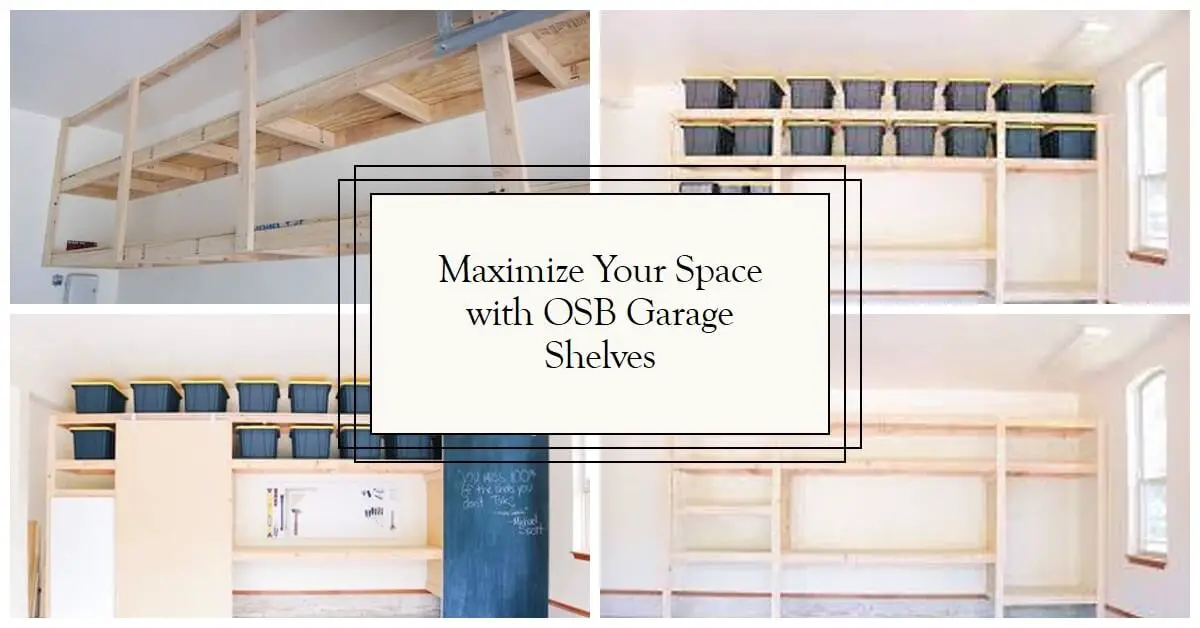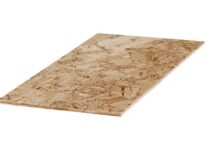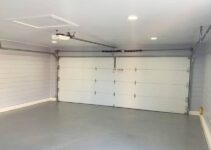Garages often become a catch-all for various items, from tools and gardening supplies to sports equipment and seasonal decorations.
To keep your garage organized and maximize the available space, investing in OSB (oriented strand board) garage shelves can be a practical and cost-effective solution.
In this article, we will explore what OSB garage shelves are, their benefits, how to choose the right OSB, step-by-step instructions for building them, organizing tips, maintenance, and commonly asked questions.
What are OSB Garage Shelves?

OSB garage shelves are sturdy and versatile storage solutions made from oriented strand board, a composite material composed of strands of wood combined with adhesives.
This engineered wood product offers several advantages over traditional shelving options, making it a popular choice for garage storage.
Benefits of OSB Garage Shelves
Versatility and Customization Options
One of the significant advantages of OSB garage shelves is their versatility and customization options. With OSB, you can create shelves of various sizes and configurations to fit your specific needs.
Whether you require long shelves for storing lumber or smaller shelves for organizing tools, OSB can be easily cut and assembled to accommodate your requirements.
Durability and Strength
OSB garage shelves are known for their durability and strength.
The layered construction of oriented strand board provides excellent load-bearing capacity, allowing the shelves to withstand the weight of heavy items without sagging or bowing.
This durability makes OSB shelves ideal for storing tools, equipment, and other substantial objects commonly found in garages.
Affordability
Compared to other shelving materials such as plywood or solid wood, OSB is a more affordable option. It offers excellent value for money without compromising on quality.
If you’re working within a budget, OSB garage shelves provide an economical solution that doesn’t sacrifice durability or functionality.
Choosing the Right OSB for Garage Shelves
When selecting OSB for your garage shelves, there are a few factors to consider to ensure optimal performance and longevity.
Thickness and Grade
The thickness and grade of the OSB are crucial for determining its strength and suitability for garage shelving. Thicker boards with higher grades generally offer greater load-bearing capacity and stability.
Consult with your local supplier or follow the manufacturer’s guidelines to choose the appropriate thickness and grade for your specific shelving needs.
Moisture Resistance
Garages can be prone to moisture and humidity, so it’s essential to select moisture-resistant OSB for your shelves.
Moisture-resistant OSB is specially treated to withstand moisture and prevent warping or damage.
Look for OSB labeled as “moisture-resistant” or “exterior-grade” to ensure its durability in a garage environment.
Load-Bearing Capacity
Consider the weight of the items you plan to store on your garage shelves and choose OSB with a suitable load-bearing capacity.
Higher-grade OSB with thicker strands and more adhesive is typically stronger and better equipped to handle heavier loads.
Be sure to check the manufacturer’s specifications to determine the load-bearing capacity of the OSB you select.
Related:
Building OSB Garage Shelves: Step-by-Step Guide
Building your own OSB garage shelves can be a rewarding and cost-effective DIY project. Follow these step-by-step instructions to create functional and sturdy shelves:

Tools and Materials Needed
Before starting, gather the necessary tools and materials:
– OSB sheets
– Measuring tape
– Circular saw or table saw
– Drill
– Screws
– Level
– Stud finder
– L-brackets or shelf brackets
Measuring and Planning
Measure the space in your garage where you intend to install the shelves.
Consider the height, width, and depth of the shelves based on the items you plan to store.
Sketch out a plan to visualize the layout and dimensions.
Cutting and Assembling the Shelves
Using a circular saw or table saw, cut the OSB sheets according to your measurements. Ensure straight and accurate cuts for precise fitting.
Assemble the shelves by attaching the cut pieces together using screws. Reinforce the corners and joints for added stability.
Securing the Shelves to the Wall
Locate the wall studs using a stud finder and mark their positions. Secure the shelves to the wall by attaching L-brackets or shelf brackets to the OSB shelves and wall studs. Use a level to ensure the shelves are straight and level.
Finishing Touches
Sand any rough edges or surfaces to make the shelves smooth and safe. If desired, you can paint or stain the OSB shelves to match your garage decor or provide extra protection.
Organizing and Maximizing Space with OSB Garage Shelves
Now that your OSB garage shelves are in place, it’s time to organize and maximize the available space:
Categorizing Items
Sort and categorize the items you plan to store on your garage shelves. Group similar items together to make them easier to find when needed.
This will help you maintain a systematic and organized approach to storage.
Utilizing Bins and Containers
Utilize bins, containers, or storage boxes to further organize smaller items.
Clear plastic containers with labels can be particularly useful for easy identification and access.
Stackable bins are also a great option to save space and create a neater appearance.
Labeling and Maintenance
Labeling is essential for quickly locating items stored on your OSB garage shelves.
Use adhesive labels, markers, or a label maker to identify the contents of each bin or container.
Regularly maintain and declutter your shelves to ensure items are stored correctly and efficiently.
Read Also:
What Is 1/4 OSB for Garage Walls?
Maintenance and Care of OSB Garage Shelves
To prolong the life and functionality of your OSB garage shelves, follow these maintenance tips:
Cleaning and Dusting
Regularly clean your OSB shelves using a soft cloth or duster to remove dust and debris. Avoid using harsh chemicals or abrasive cleaners, as they may damage the surface of the OSB.
If necessary, lightly dampen the cloth with water or a mild cleaning solution specifically designed for wood.
Addressing Moisture Issues
Monitor your garage for any signs of moisture or water leaks. If you notice dampness or excessive humidity, address the issue promptly to prevent damage to your OSB shelves.
Consider installing a dehumidifier or improving ventilation to maintain an optimal environment.
Regular Inspections
Periodically inspect your OSB garage shelves for any signs of wear, damage, or instability. Check for loose screws, sagging shelves, or warping. Address any issues immediately to maintain the structural integrity and safety of your shelves.
Conclusion
OSB garage shelves offer a practical, versatile, and affordable storage solution for keeping your garage organized and maximizing space.
With their durability, strength, and customization options, OSB shelves provide an excellent platform for organizing tools, equipment, and various household items.
By following the step-by-step instructions for building and installing OSB garage shelves, coupled with effective organization strategies and proper maintenance, you can transform your garage into a functional and well-organized space.


